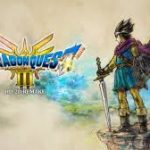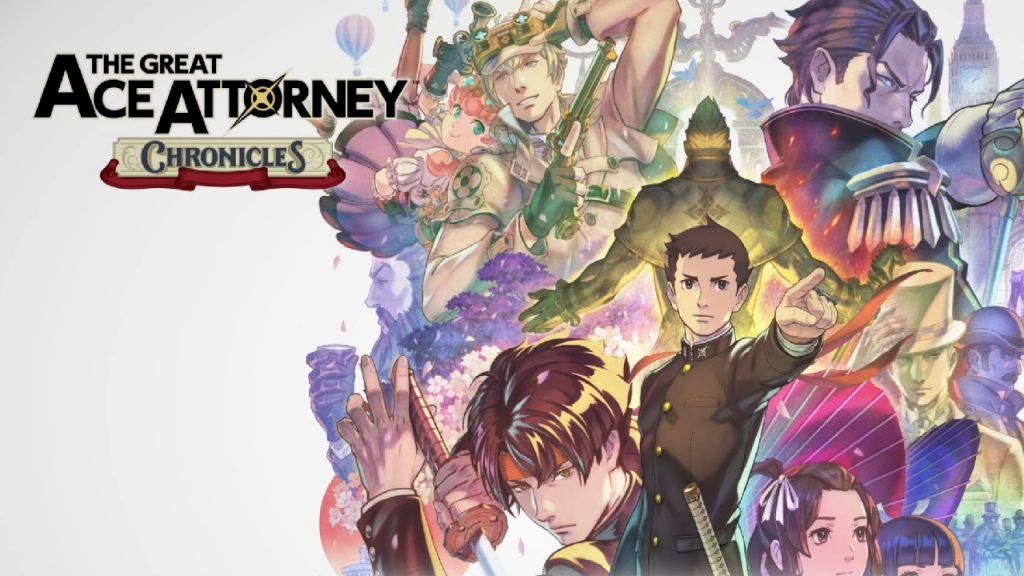I really liked Ace Attorney when the first one popped up in the Americas. It was a pretty cool mix of the classic point-and-click gameplay and some visual novel-style storytelling. Which is funny because I don’t like visual novels. As far as Ace Attorney, I played the first 3, Investigations 1 and Apollo Justice. I didn’t play the second and third Apollo Justice games, or the second Investigations.
This is a collection of 2 games in the series, a prequel spin-off series that takes place at least a hundred years before the first game, featuring an ancestor of Ryuichi Naruhodo, known to us as Phoenix Wright. These 3DS games didn’t previously come out in the west, so this collection is the only way to play these in english.
Considering the gameplay of Ace Attorney, this won’t be a super long review, especially since I don’t want to really spoil the story.
So let’s go!
Developer and Publisher: Capcom
Release date: July 27th 2021
Platforms: Switch, PC, PS4 (Switch version played)
Genre: Point-and-click Adventure
So this story takes place in the Meihi era in japan (so basically late 1800s). You play as Ryunosuke Naruhodo, an ancestor of Ryuichi himself from the other Ace Attorney games. The game starts with you being accused of a murder, with very solid evidence against you. You end up representing yourself in court, with the help of his best friend Kazuma. This starts Ryunosuke’s path in becoming a defense lawyer. After winning the case, Kazuma asks Ryunosuke to follow him and judicial assistant Susato on a student trip to Great Britain, where Kazuma is meant to learn the art of lawyering. However something happens along the way and it ends with Ryunosuke replacing Kazuma on the student tour, with Susato still acting as his judicial assistant. In England he is tested in a tough case to defend a rich man accused of murder, and will be allowed to take on the study tour in Kazuma’s place if he’s succesful. He’s asked largely because no other lawyer wants to fight against the infamous prosecutor Barok von Zieks, also known as the Reaper of Old Bailey. A prosecutor who leads the defendants to a tragic end no matter what, whether they be guilty or not. Not that he kills them if they’re not guilty, but some accident does end up happening to them. Fun! Ryunosuke and Susato also end up meeting and living with Sherlock Holmes (who they encountered a bit before getting the England), and from there take on various murder cases.
A weird thing with this story is that literally every case Ryunosuke and Susato take on have to do with a specific case from 10 years ago. You hear a little bit about it in the first game, but the second game is basically all about that case from 10 years ago, where the pieces of the puzzle start falling in place. And it’s not just the people involved, but the events themselves being intrinsically linked. You’d think maybe Ryunosuke takes on other cases in-between the ones we see… but the text tells us that… no. He doesn’t. The cases we see are all the cases he gets, and they’re all linked to “The Professor” in some way. Sometimes the link is a bit minor, but it ends up being really important. Some of those links are given to us later, mostly in the second game, but yeah… If you don’t like coincidence in storytelling, you might have issues with this. Though yes, the world of Ace Attorney does run on coincidence a lot, so it’s kind of to be expected.
As for the overarching plot, I’m pretty sure all questions are answered by the end, the knots are all tied in satisfactory ways, the characters grow up (especially van Zieks). If I had to find any holes here, it would be… Iris is 10, but she’s already an accomplished writer and inventor when you meet her. I do otherwise like her, but it’s a bit much to believe that she’d be a well-published writer for seemingly years before the game starts. Had not too many issues suspending my disbelief with this one, since she does live with Sherlock who is himself a big inventor of gadgets and stuff, and has the materials Iris uses for her writing (notes from Sherlock’s assistant). Oh, and there’s one thing at the very end of the story that’s all sorts of bullshit technology-wise, but it’s cool so I’ll let it slide.
Localization is fine for the most part. There’s a few small parts that I think are probably not like in the original japanese version, but for the most part it seems fine. I just have an issue with Sherlock Holmes… specifically the fact that they don’t call him Sherlock Holmes in the english version. But if you do like me and have the japanese voices, they do call him Sherlock in that version. So why doesn’t the english version call him Sherlock? He’s called Sherlock in the game anyways if you just change the language, so why is it an issue in the english text, but not in the japanese text? I refuse to call him “Herlock Sholmes”, it sounds stupid. Nor do I want to call Watson “Wilson”. Fuck off with that shit. If it’s okay to call him Sherlock in japanese, there’s no reason not to call him Sherlock in english. Yes this was a paragraph complaining about one name in the game.
Visually it looks good. The characters are all 3D which I thought might detract from the style a bit, and I will say some animations are a bit much, but overall they do actually look great. Sometimes I even forgot I was looking at 3D models. Of course these 3D models ARE from a 3DS game, and it kinda shows, but it still looks good despite that, and they have pretty smooth animation. Otherwise I have no problem with the rest of the graphics. There’s a few times, more gameplay-related, that there’s stuff I wanted to investigate in environments that the game just wasn’t letting me.
So the gameplay… It’s much like you remember from other Ace Attorney games. You read text, press A to advance… you know the stuff. In court you cross-examine witness testimony, where you can press the witness for more info on their statements, and you can present evidence on certain lines of testimony if you have evidence that contradicts what is being told. Of course you’re sometimes asked to present evidence outside of this (or point to people who may be culprits or witnesses). Evidence can be examined, and some of it is 3D so you can look at things more in detail. Sometimes this changes what you know about that piece of evidence, so something that won’t contradict witness testimony might if you found something specific on an object. Some of these objects can also be manipulated when you examine them, like opening a book/box and such.
In investigation segments it’s much like before too, you point at the environment, click on things, which gives you conversations between characters, or makes you find evidence for the court case. You can converse with characters in the different locations, as well as present evidence to them so you can progress the story. Much like other point-and-click adventure games, you need to figure out, may it be in court or investigations, what specific object to use on what specific “thing” (in this case “thing” usually being something someone said).
But this game DOES have some new stuff (or at least stuff I don’t recall from previous games). Sherlock comes in during your investigation sometimes to “deduce” things about characters, and he’s awful at it. So you take his deduction and “correct” it. This allows you to, generally, look at characters and environments in 3D and find the correct evidence that Sherlock didn’t notice, improving his deduction and getting the truth about the situation. Sherlock’s deductions are always awful without your help, sometimes bringing some pretty fantastical things. That’s pretty much the only new thing in investigations. I find it okay, but also just too easy.
In court there’s a few interesting new things. There’s a jury system in court here. This doesn’t quite matter as far as gameplay, specific events will just make jury members decide on the defendant being guilty and such. At some points the jury will all agree on a guilty verdict, which will lead to you having to convince the jury to reverse course, which is the actual gameplay part here. It works like cross-examination, but instead of just presenting evidence on certain statements, here the jury members will say why they think the defendant is guilty (or not, the court system is pretty lax) and you’ll need to press for precision (sometimes changing the statements), and then you’ll have to pit 2 statements against each other if they’re contradictory or something, which usually brings out some more information about the case. I like this element, it’s a fun take on the whole “finding contradictions” thing.
Also, during witness testimony, there’s generally several witnesses. When you press statements, sometimes other witnesses will react to something the other witness said, so you can talk to that other witness and ask them why they’re freaking out. This WOULD be a pretty interesting element… IF it wasn’t so freakishly obvious. They have a big sound playing, and the icons representing the witnesses get a big red exclamation mark on it, so you can never miss it. And much like when the game asks you if you want to object to something or whatever, you always do it. I would like if this element was a bit more subtle.
So I figure before I end this review, I’ll give vague opinions about each game case by case. The first game starts with a trial-only chapter as usual, with actually Payne/Auchi’s ancestor (I think the only other ancestor to a character from the main series) as the prosecutor. It’s decent, actually longer than I was expecting. The second chapter is a bit meh, as there’s no trial, just a very small bit of investigation and deduction. Third chapter is a trial that has several pretty good twists but is mostly good for character development. Fourth chapter has one investigation segment and then a trial, it’s pretty decent and a bit weird. Fifth chapter is really interesting overall because it’s the biggest piece of foreshadowing for the second game as far as the big overarching plot, though yes every other chapter before it does still have to do with that plot, in ways you just don’t know yet. It also features lots of Gina which I’m good with. Overall the first game is a bit non-standard as far as Ace Attorney, as there’s no chapter with the usual “investigation > trial > investigation part 2 > trial part 2” structure that all the other ones do.
This does change in the second game though, as many of the chapters do have that traditional structure. The first chapter is still an intro case, though it’s actually a direct continuation to the first case in the first game, so that’s fun. The second chapter actually goes in the past, in-between chapters 3 and 4 in the first game, and this one has the traditional structure. Chapter 3 is a big traditional structure murder case which opens up a lot about the case from 10 years ago. And then Chapter 4 AND 5 are one case, sort of, that cover both that one murder and the overarching story all in one big shot. Chapter 4 is kinda traditional structure, while 5 mostly isn’t. Game 2 is definitely a bit better than the first in the collection, though both are good. The first doesn’t have the best cases (chapter 2 is especially meh), the second one leans a bit TOO much on the overarching plot so the separate cases feel a bit overtaken by that.
Overall
This was pretty good. If I have any complaints, it’s how long it is. There’s just a LOT of text in there that could definitely be skipped, like flashbacks to things that just happened, and stuff that’s more there for flavor than usefulness.
The story is largely pretty good, except for the coincidence aspect which gets more weird as the game progresses. Literally every single court case Ryunosuke participates in as a defense lawyer is intrinsically connected to one specific case from 10 years ago in some way. Even the ones that seem like they aren’t at first, are later revealed to have been, in fact, related. And we know there’s no other cases that he participates in in-between the ones we see, which makes it all a bit TOO coincidental.
That said, I still think it’s a pretty good plot. The big mystery is interesting, it’s written in a way that actually mostly logically follows with almost no weird out-of-nowhere deus ex machina (there’s only a couple pieces of evidence that come up from nothing, especially how the first case is resolved), most events are actually well foreshadowed, and I actually like several of the characters (especially Gina and Iris).
This is a pretty good game. I recommend it. Could’ve done with more tap-dancing Mikitoba though.
Also be careful when playing in handheld, as even touching just a pixel of the screen makes the text go in super-turbo mode.








Leave a reply